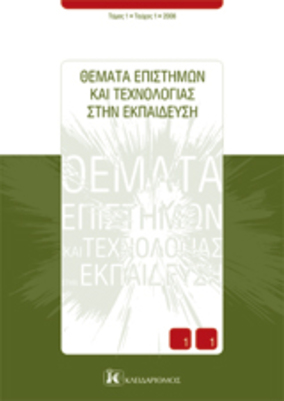Ιστορικές αναφορές στα εγχειρίδια Βιολογίας Λυκείου
Part of : Θέματα επιστημών και τεχνολογίας στην εκπαίδευση ; Vol.5, No.1-2, 2012, pages 99-112
Issue:
Pages:
99-112
Abstract:
Η εργασία αυτή επικεντρώνει το ενδιαφέρον της στις ιστορικές αναφορές των εγχειριδίων Βιολογίας Λυκείου και μελετά τα χαρακτηριστικά τους. Η σημασία της ένταξης της ιστορίας στη διδακτική πράξη αναγνωρίζεται ως μια προτεραιότητα στην εκπαίδευση γιατί αφενός κάνει φανερό το άλλο πρόσωπο της επιστήμης, της ανθρώπινης προσπάθειας, στους μαθητές και αφετέρου δημιουργεί ενδιαφέροντα διδακτικά περιβάλλοντα. Η επαγωγική ανάλυση περιεχομένου υιοθετήθηκε για τη μελέτη των ιστορικών αναφορών στα σχολικά βιβλία και τρεις από τις διαστάσεις που εντοπίστηκαν συζητούνται στην παρούσα εργασία. Το είδος των ιστορικών αναφορών, η σχέση τους με το περιεχόμενο που εντάσσονται και τα χαρακτηριστικά της επιστήμης που αναδεικνύουν μελετώνται. Τα ευρήματα δείχνουν ότι ο τρόπος ένταξης των ιστορικών αναφορών στα εγχειρίδια έχει ενδιαφέρον και το ζήτημα της αξιοποίησης εκ μέρους των εκπαιδευτικών αποκτά ιδιαίτερη σημασία.
Subject:
Subject (LC):
Keywords:
ανάλυση σχολικών βιβλίων, ιστορία των ΦΕ, φύση και εξέλιξη της βιολογίας, βιολογία λυκείου, ιστορικές αναφορές
Notes:
Περιέχει σχήματα, πίνακες και βιβλιογραφία, Το άρθρο περιέχεται στο ειδικό αφιέρωμα: "Αλληλεπιδράσεις εκπαιδευτικής έρευνας και πράξης στις Φυσικές Επιστήμες"
References (1):
- Abd-El-Khalick, F., & Lederman, N. G. (2000). The influence of history of science courses on students΄views onnature of science. Journal of Research in Science Teaching, 37(10), 1057-1059.American Association for the Advancement of Science (2000). Big biology books fail to convey big ideas, reportsAAAS's Project 1061. Science Books & Films, 36(5), 199-202. Retrieved 12 May 2007 fromwww.project2061.org/newsinfo/press/rl000627.htm.Bell, R. L., Matkins, J. J., & Gansneder, B. M. (2011). Impacts of contextual and explicit instruction on preserviceelementary teachers' understandings of the nature of science. Journal of Research in Science Teaching, 48(4), 414-436.Bliss, J., Monk, M., & Ogborn, J. (1983). Qualitative Data Analysis for Educational Research. London: Croom Helm.Chamany, Κ., Allen, D., & Tanner, K. (2008). Making biology learning relevant to students: Ιntegrating people,history, and context into college biology teaching. CBE - Life Sciences Education, 7(3), 267-278.Chiappetta, E. L., & Fillman, D. A. (2007). Analysis of five high school biology textbooks used in the united statesfor inclusion of the Nature of Science. International Journal of Science Education, 29(15), 1847-1868.Creath, R. (2010). The role of history in Science. Journal of the History of Biology, 43(2), 207-214.Dolphin, G. (2009). Evolution of the theory of the earth: A contextualized approach for teaching the history of thetheory of plate tectonics to ninth grade student. Science & Education, 18, 425-441.Drakopoulou, M., Skordoulis, K., & Halkia, K. (2004). History of Science (HOS) integration in 20th century Greekprimary school science textbooks. Paper presented at the European Conference on Educational Research (ECER),University of Crete, September 22-25.Duschl, R. A. (1994). Research on the history and philosophy of science. In D. L. Gabel (ed.), Handbook of researchon science teaching and learning (pp. 443–465). New York: MacMillan.Eichman, P. (1996). Using History to teach Biology. The American Biology Teacher, 58(4), 200-204.Haidar, A. H (1997). Prospective chemistry teachers΄conceptions of the conservation of matter and relatedconcepts. Journal of Research in Science Teaching, 34, 181-197.Kafai, B. Y., & Gilliland-Swetland, A. J. (2001). The use of historical materials in elementary science classrooms.Science Education, 85, 349-367.Kindi, V. (2005). Should science teaching involve the history of science? An assessment of Kuhn‟s view. Science &Education, 14, 721-731.Kuhn, T. S. (2006). The structure of scientific revolutions. Chicago: University of Chicago Press.Masson, S. & Vázquez-Abad, J. (2006). Integrating history of science through historical microworlds to promoteconceptual change. Journal of Science Education and Technology, 15(3), 257-268.Matthews, M.R. (1994). Science Teaching: The Role of History and Philosophy of Science. NY: Routledge.Mayring, P. (2000). Qualitative Content Analysis. Forum: Qualitative Social Research, 1(2). Retrieved 25 March 2007from http://www.qualitative-research.net/fqs-texte/2-00/2-00mayring-e.htm.McComas, W. F. (2008). Seeking historical examples to illustrate key aspects of the nature of science. Science &Education, 17, 249-263.Michael, I. (1998). Textbooks as history: the work of the Colloquium. Paradigm, 25. Retrieved 25 March 2007 fromhttp://faculty.education.illinois.edu/westbury/paradigm/michael2.html.Monk, M., & Osborne, J. (1997). Placing the history and philosophy of science on the curriculum: A model for thedevelopment of pedagogy. Science Education, 81, 405–424.Olson, J. K., Clough, M. P., Bruxvoort, C. N., & Vanderlinden, D. W. (2005). Improving students‟ nature of scienceunderstanding through historical short stories in an introductory geology course. Spring 2005 CFCS/COEStudent Presentations and Papers at National and International Meetings and Conferences. Retrieved 27 April 2007from http://www.hs.iastate.edu/students/2005/springpapers.Osborne, J. (2005). The role of argument in science education. Ιn K. Boerska, M. Goedhart, O. De Jong & H.Eijkelhof (eds.), Research and the Quality of Science Education (pp. 367-380). Dordrecht: Springer.Sepel, L. M. N., Loreto, E. L. S., & Rocha, J. B. T. (2009). Using a replica of Leeuwenhoek‟s microscope to teach thehistory of science and to motivate students to discover the vision and the contributions of the firstmicroscopists. CBE - Life Sciences Education, 8, 338–343.Solomon, J. (1991). Teaching about the Nature of Science in the British National Curriculum. Science Education,75(1), 95-103.Spiliotopoulou, V., & Agelopoulos K. (2008). Enhancement of pre-service teachers' teaching interventions withthe aid of historical examples. Science & Education, 18(9), 1153-1175.Tobin, K. (1990). Research on science laboratory activities: In pursuit of better questions and answers to improvelearning. School Science and Mathematics, 90, 403-418.Verhave, Τ., & Sherman, J.G. (1968). Principles of textbook analysis. Journal of the Experimental Analysis of Behavior,11, 641-649.Αδαμαντιάδου, Σ., Γεωργάτου, Μ., Γιαπιτζάκης, Χ., Λάκκα, Λ., Νοταράς, Δ., Φλωρεντίν, Ν., Χατζηγεωργίου, Γ.,& Χαντηκώντη, Ο. (2003). Βιολογία Γενικής Παιδείας Γ’ τάξης Ενιαίου Λυκείου (2η έκδ.). Αθήνα: Ο.Ε.Δ.Β..Ανακτήθηκε στις 27 Απριλίου 2007 από http://www.pi-schools.gr/lessons/biology.Αλεπόρου – Μαρίνου, Β., Αργυροκαστρίτης, Α., Κομητοπούλου, Α., Πιαλόγλου, Π., & Σγουρίτσα, Β. (2008).Βιολογία Θετικής κατεύθυνσης Γ’ τάξης Γενικού Λυκείου (Θ’ έκδ.). Αθήνα: Ο.Ε.Δ.Β..Καψάλης, Α., Μπουρμπουχάκης, Ι., Περάκη, Β., & Σαλαμαστράκης, Σ., (2007). Βιολογία Γενικής Παιδείας Β’ τάξηςΓενικού Λυκείου. Αθήνα: Ο.Ε.Δ.Β..Κυριακού, Κ., Σταύρου, Ι., & Σκορδούλης, Κ. (2007). Όροι της Οικολογίας στα σχολικά εγχειρίδια ΦυσικήςΙστορίας και Βιολογίας από το 1866 έως σήμερα. Στο Α. Κατσίκης, Κ. Κώτσης, Α. Μικρόπουλος & Γ.Τσαπαρλής (επιμ.), Πρακτικά 5ου Πανελληνίου Συνεδρίου Διδακτική Φυσικών Επιστημών και Νέες Τεχνολογίες στηνΕκπαίδευση (Τόμος Β‟, σ. 759-766). Ιωάννινα: Πανεπιστήμιο Ιωαννίνων. Ανακτήθηκε στις 27 Απριλίου 2007από http://www.kodipheet.gr/fifth_conf/pdf_synedriou/teyxos_B/4_didakt_didask_viol/3_BIO-02telikiF.pdf




